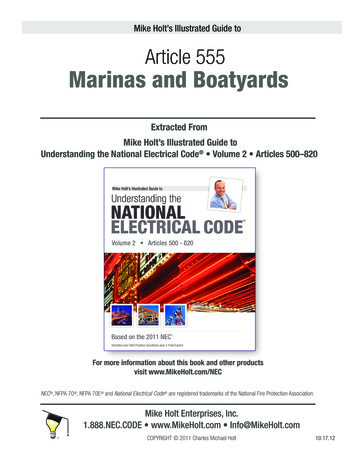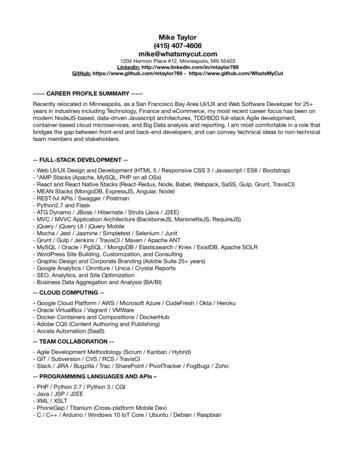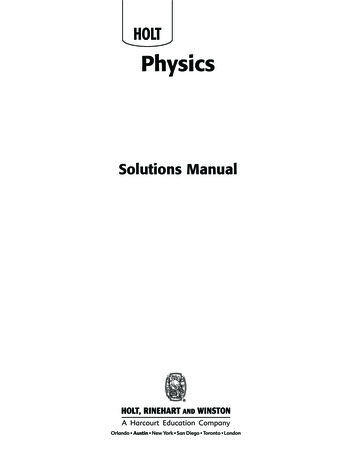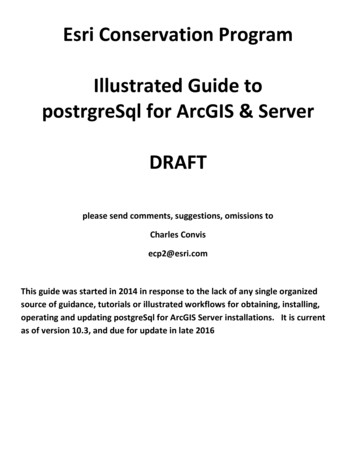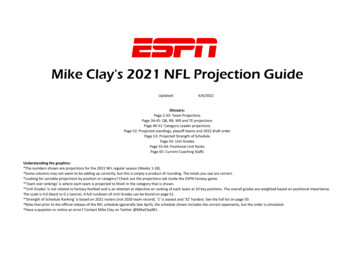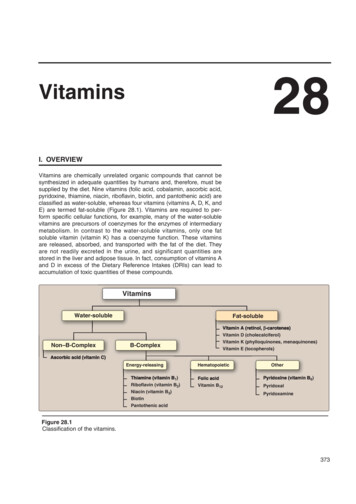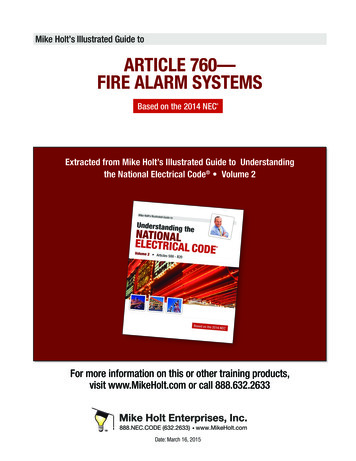
Transcription
Mike Holt’s Illustrated Guide toARTICLE 760—FIRE ALARM SYSTEMSBased on the 2014 NEC Extracted from Mike Holt’s Illustrated Guide to Understandingthe National Electrical Code Volume 2For more information on this or other training products,visit www.MikeHolt.com or call 888.632.2633Date: March 16, 2015
NOTICE TO THE READERThe publisher does not warrant or guarantee any of theproducts described herein or perform any independentanalysis in connection with any of the product informationcontained herein. The publisher does not assume, andexpressly disclaims, any obligation to obtain and includeinformation other than that provided to it by the manufacturer.The reader is expressly warned to consider and adopt allsafety precautions that might be indicated by the activitiesherein and to avoid all potential hazards. By following theinstructions contained herein, the reader willingly assumesall risks in connection with such instructions.The publisher makes no representation or warranties ofany kind, including but not limited to, the warranties of fitness for particular purpose or merchantability, nor are anysuch representations implied with respect to the materialset forth herein, and the publisher takes no responsibilitywith respect to such material. The publisher shall not beliable for any special, consequential, or exemplary damages resulting, in whole or part, from the reader’s use of,or reliance upon, this material.Author: Mike HoltTechnical Illustrator: Mike CulbreathCOPYRIGHT 2015 Charles Michael HoltProduced and Printed in the USAAll rights reserved. No part of this work covered by thecopyright hereon may be reproduced or used in any form orby any means graphic, electronic, or mechanical, includingphotocopying, recording, taping, or information storageand retrieval systems without the written permission ofthe publisher. You can request permission to use materialfrom this text by either calling 888.632.2633, e-mailingInfo@MikeHolt.com, or visiting www.MikeHolt.com.ABOUT THE AUTHORMike Holt worked his way up throughthe electrical trade. He began as anapprentice electrician and becameone of the most recognizedexperts in the world as it relatesto electrical power installations.He’s worked as a journeymanelectrician, master electrician, and electrical contractor.Mike’s experience in the realworld gives him a uniqueunderstanding of how the NECrelates to electrical installations from a practical standpoint.You’ll find his writing style to be direct, nontechnical,and powerful.Did you know Mike didn’t finish high school? Soif you struggled in high school or didn’t finish at all,don’t let it get you down. However, realizing that success depends on one’s continuing pursuit of education,Mike immediately attained his GED, and ultimatelyattended the University of Miami’s Graduate School fora Master’s degree in Business Administration.Mike resides in Central Florida, is the father of sevenchildren, has five grandchildren, and enjoys many outside interests and activities. He’s a nine-time NationalBarefoot Water-Ski Champion (1988, 1999, 2005–2009, 2012–2013). He’s set many national recordsand continues to train year-round at a World competition level (www.barefootwaterskier.com).What sets him apart from some is his commitmentto living a balanced lifestyle; placing God first, family,career, then self.For more information, call 888.NEC.CODE (632.2633), ore-mail Info@MikeHolt.com.NEC , NFPA 70 , NFPA 70E and National ElectricalCode are registered trademarks of the National FireProtection Association.This logo is a registered trademark of MikeHolt Enterprises, Inc.I dedicate this book to theLord Jesus Christ,my mentor and teacher.Proverbs 16:3
ARTICLE760FIRE ALARM SYSTEMSIntroduction to Article 760—Fire Alarm SystemsArticle 760 covers the installation of wiring and equipment for fire alarm systems, including circuits controlled and poweredby the fire alarm. These include fire detection and alarm notification, guard’s tour, sprinkler waterflow, and sprinkler supervisory systems. NFPA 72, National Fire Alarm Code provides other fire alarm system requirements.Part I. GeneralAuthor’s Comment:n760.1 ScopeArticle 760 covers the installation of wiring and equipment for firealarm systems, including circuits controlled and powered by the firealarm system. Figure 760–1Residential smoke alarm systems, including interconnecting wiring, aren’t covered by Article 760, because they aren’tpowered by a fire alarm system as defined in NFPA 72.Note 1: Fire alarm systems include fire detection and alarm notification, guard’s tour, sprinkler waterflow, and sprinkler supervisorysystems. Other circuits that might be controlled or powered by the firealarm system include elevator capture, elevator shutdown, door release,smoke doors and damper control, fire doors and damper control, and fanshutdown.NFPA 72, National Fire Alarm and Signaling Code, provides the requirements for the selection, installation, performance, use, testing, andmaintenance of fire alarm systems.Author’s Comment:Figure 760–1FREE PDF—Fire Alarm Systems 2014 NEC3nBuilding control circuits associated with the fire alarmsystem, such as elevator capture and fan shutdown, mustcomply with Article 725 [760.3(E)]. Article 760 applies ifthese components are powered and directly controlled by thefire alarm system.nNFPA 101—Life Safety Code or the local building code specifies when and where a fire alarm system is required.www.MikeHolt.com 888.NEC.CODE (632.2633)
Article 760 Fire Alarm Systems760.2 DefinitionsAbandoned Fire Alarm Cable. A cable that isn’t terminated to equipment and not identified for future use with a tag.Author’s Comment:nSection 760.25 requires the accessible portion of abandonedcables to be removed.Fire Alarm Circuit. The portion of the wiring system and connectedequipment powered and controlled by the fire alarm system. Fire alarmcircuits are classified as either nonpower-limited or power-limited.Nonpower-Limited Fire Alarm Circuit. A nonpower-limited fire alarmcircuit can operate at up to 600V, and the power output isn’t limited[760.41 and 760.43]. Figure 760–2Figure 760–3Not Inherently Limited [Chapter 9, Table 12(A)]Overcurrent VoltagePowerProtection0V to 20V5.00 x V5A21V to 100V100 VA100/V101V to 150V100 VA1AAuthor’s Comment:nInherently limited power supplies are designed to burn out ifoverloaded.760.3 Other ArticlesFigure 760–2Only those sections of Article 300 specifically referenced in this article apply to fire alarm systems, and fire alarm circuits and equipmentmust comply with (A) through (G) as follows:Power-Limited Fire Alarm Circuit. A power-limited fire alarm circuitmust have the voltage and power limited by a listed power supply thatcomplies with 760.121 as follows: Figure 760–3(A) Spread of Fire or Products of Combustion. Fire alarm circuitsinstalled through fire-resistant-rated walls, partitions, floors, or ceilings must be firestopped to limit the possible spread of fire or productsof combustion in accordance with the instructions supplied by themanufacturer for the specific type of cable and construction material(drywall, brick, and so forth) [300.21]. Figure 760–4Inherently Limited (ac) [Chapter 9, Table 12(A)]VoltagePower0V to 20V5.00 x V21V to 100V100 VAFREE PDF—Fire Alarm Systems 2014 NEC4www.MikeHolt.com 888.NEC.CODE (632.2633)
Article 760 Fire Alarm SystemsFigure 760–5Figure 760–4(D) Corrosive, Damp, or Wet Locations. Fire alarm circuits installedin corrosive, damp, or wet locations must be identified for use in theoperating environment [110.11], must be of materials suitable for theenvironment in which they’re to be installed, and must be of a typesuitable for the application [300.5(B), 300.6, 300.9, and 310.10(G)].Question: How many 18 TFFN fixture wires can be installed intrade size ½ electrical metallic tubing? Figure 760–6(a) 22(b) 26(c) 30(d) 40Answer: (a) 22 conductors [Annex C, Table C.1](E) Building Control Circuits. Class 1, 2, and 3 circuits used for building controls (elevator capture, fan shutdown, and so on), associatedwith the fire alarm system, but not controlled and powered by the firealarm system, must be installed in accordance with Article 725 [760.1].(F) Optical Fiber Cables. Optical fiber cables utilized for fire alarm circuits must be installed in accordance with Article 770.(H) Raceways or Sleeves Exposed to Different Temperatures. If araceway or sleeve is subjected to different temperatures, and wherecondensation is known to be a problem, the raceway or sleeve mustbe filled with a material approved by the authority having jurisdiction that will prevent the circulation of warm air to a colder sectionof the raceway. An explosionproof seal isn’t required for this purpose[300.7(A)]. Figure 760–5(J) Number and Size of Conductors in a Raceway. Raceways mustbe large enough to permit the installation and removal of conductorswithout damaging conductor insulation [300.17].Figure 760–6Author’s Comment:n(K) Bushing. When a raceway is used for the support or protection ofcables, a bushing to reduce the potential for abrasion must be placedat the location where the cables enter the raceway in accordance with300.15(C). Figure 760–7When all conductors in a raceway are the same size andinsulation, the number of conductors permitted can be foundin Annex C for the raceway type.FREE PDF—Fire Alarm Systems 2014 NEC5www.MikeHolt.com 888.NEC.CODE (632.2633)
Article 760 Fire Alarm SystemsFigure 760–7Figure 760–8760.21 Access to Electrical EquipmentBehind Panels Designed to Allow AccessAccess to equipment must not be prohibited by an accumulation ofcables that prevent the removal of suspended-ceiling panels.Author’s Comment:nCables must be located so that the suspended-ceiling panelscan be moved to provide access to electrical equipment.760.24 Mechanical Execution of WorkFigure 760–9(A) General. Equipment and cabling must be installed in a neat andworkmanlike manner.Cables installed through or parallel to framing members or furringstrips must be protected where they’re likely to be penetrated by nailsor screws, by installing the wiring method so it isn’t less than 1¼ in.from the nearest edge of the framing member or furring strips, orby protecting them with a 1 16 in. thick steel plate or the equivalent[300.4(D)]. Figure 760–10Exposed cables must be supported by the structural components ofthe building so that the cable won’t be damaged by normal building use. Cables must be supported by straps, staples, hangers, cableties, or similar fittings designed and installed in a manner that won’tdamage the cable. Figure 760–8Author’s Comment:nRaceways and cables above a suspended ceiling must besupported by independent support wires attached to the suspended ceiling [300.11(A), 760.46, and 760.130]. Figure760–9FREE PDF—Fire Alarm Systems 2014 NEC6www.MikeHolt.com 888.NEC.CODE (632.2633)
Article 760 Fire Alarm SystemsFigure 760–10Figure 760–12Author’s Comment:760.25 Abandoned CablenTo limit the spread of fire or products of combustion within a building, the accessible portion of cable that isn’t terminated at equipmentand not identified for future use with a tag must be removed [760.2].Figure 760–11Cables installed in concealed raceways aren’t considered“accessible”; therefore, they’re not required to be removed.760.30 Fire Alarm Circuit IdentificationFire alarm circuits must be identified at terminal and junction locations.The identification must be in such a manner that will help to preventunintentional signals on the fire alarm system circuits during testingand servicing of other systems. Figure 760–13Figure 760–11Cables identified for future use must be with a tag that can withstandthe environment involved. Figure 760–12FREE PDF—Fire Alarm Systems 2014 NECFigure 760–137www.MikeHolt.com 888.NEC.CODE (632.2633)
Article 760 Fire Alarm SystemsThe location of the branch-circuit overcurrent device for thepower-limited fire alarm equipment must be permanently identified atthe fire alarm control unit. Figure 760–15760.32 Fire Alarm Circuit CablesExtending Beyond a BuildingIf fire alarm circuit conductors extend beyond a building and run outdoors, they must be installed in accordance with Parts II, III, and IV ofArticle 800, and they must also be installed in accordance with Part Iof Article 300.760.35 Fire Alarm Circuit Requirements(A) Nonpower-Limited Fire Alarm Circuits. Nonpower-limited firealarm (NPLFA) circuits must comply with Parts I and II of this article.(B) Power-Limited Fire Alarm Circuits. Power-limited fire alarm(PLFA) circuits must comply with Parts I and III of this article.Figure 760–15Part III. Power-Limited Fire Alarm(PLFA) CircuitsThe branch-circuit overcurrent device must be identified in red, accessible only to qualified personnel, and identified as “FIRE ALARMCIRCUIT.” The red identification must not damage the overcurrent protective device or obscure any manufacturer’s markings. Figure 760–16760.121 Power Sources forPower-Limited Fire Alarm Circuits(B) Branch Circuit. Power-limited fire alarm equipment must be supplied by a branch circuit that supplies no other load and isn’t GFCI orAFCI protected. Figure 760–14Figure 760–16Figure 760–14FREE PDF—Fire Alarm Systems 2014 NEC8www.MikeHolt.com 888.NEC.CODE (632.2633)
Article 760 Fire Alarm SystemsAuthor’s Comment:760.124 Equipment MarkingnFire alarm equipment supplying power-limited fire alarm cable circuitsmust be durably marked to indicate each circuit that’s a power-limitedfire alarm circuit.Author’s Comment:nFire alarm circuits must be marked at terminal and junctionlocations [760.30].760.130 Wiring Methods on Load Side ofPower-Limited Fire Alarm Power SourceExposed cables must be supported by the structural components of the building so the cable won’t be damaged bynormal building use. Cables must be secured by straps, staples, hangers, or similar fittings designed and installed ina manner that won’t damage the cable. Cables installedthrough or parallel to framing members or furring strips mustbe protected where they’re likely to be penetrated by nails orscrews, by installing the wiring method so it isn’t less than1¼ in. from the nearest edge of the framing member or furring strips, or it must be protected by a 1 16 in. thick steelplate or the equivalent [760.24(A)].760.135 Installation of PLFACables in Buildings(B) PLFA Wiring Methods and Materials. Power-limited fire alarmconductors and cables described in 760.179 must be installed asdetailed in (1), (2), or (3) of this section and 300.7.Installation of power-limited fire alarm cables in buildings must complywith 760.135(A) through (J).(1) Exposed or Fished in Concealed Spaces. Cable splices or terminations must be made in listed fittings, boxes, enclosures, fire alarmdevices, or utilization equipment. Figure 760–17(A) Listing. PLFA cables installed in buildings must be listed.(C) Plenum Spaces. Plenum rated FPLP cables are permitted inplenum spaces as described in 300.22(C). Figure 760–18Figure 760–17Figure 760–18Power-limited fire alarm cable installed exposed must be adequatelysupported and protected against physical damage.(H) Other Building Locations. The following cables are permitted tobe installed in building locations other than the locations covered in770.113(B) through (H):FREE PDF—Fire Alarm Systems 2014 NEC9www.MikeHolt.com 888.NEC.CODE (632.2633)
Article 760 Fire Alarm Systems(1) Types FPLP, FPLR, and FPL cables(2) Types FPLP, FPLR, and FPL cables installed in:a. Plenum communications racewaysb. Plenum cable routing assembliesc. Riser communications racewaysd. Riser cable routing assembliese. General-purpose communications racewaysf. General-purpose cable routing assemblies(3) Types FPLP, FPLR, and FPL cables installed in a raceway of a typerecognized in Chapter 3Figure 760–19760.136 Separation fromPower Conductors760.139 Power-Limited Fire AlarmCircuits, Class 2, Class 3, andCommunications Circuits(A) General. Power-limited fire alarm conductors must not be placedin any enclosure, raceway, or cable with conductors of electric light,power, or Class 1 circuits.(A) Two or More PLFA Circuits. Power-limited fire alarm circuits,communications circuits, or Class 3 circuits can be in the same cable,enclosure, cable tray, raceway, or cable routing assembly. Figure760–20(B) Separated by Barriers. If separated by a barrier, power-limited firealarm circuits are permitted with electric power conductors.Author’s Comment:nSeparation is required to prevent a fire or shock hazard thatcan occur from a short between the fire alarm circuit and thehigher-voltage circuits.(D) Associated Systems Within Enclosures. Power-limited fire alarmconductors can be mixed with electric light, power, and Class 1 circuitconductors in enclosures where these other conductors are introducedsolely for connection to the same equipment, and:(1) A minimum of ¼ in. separation is maintained from the powerlimited fire alarm cable conductors.(G) Other Applications. Power-limited fire alarm circuit conductorsmust be separated by not less than 2 in. from insulated conductors ofelectric light, power, or Class 1 circuits unless:(1) Electric light, power, Class 1 circuit conductors, or power-limitedfire alarm circuit conductors, are in a raceway or in metal-sheathed,metal-clad, nonmetallic-sheathed, or underground feeder cables.Figure 760–19FREE PDF—Fire Alarm Systems 2014 NECFigure 760–2010www.MikeHolt.com 888.NEC.CODE (632.2633)
Article 760 Fire Alarm Systems(B) PLFA and Class 2 Circuits. Class 2 circuits can be within thesame cable, cable routing assembly, enclosure, cable tray, or raceway as conductors of power-limited fire alarm circuits provided theClass 2 circuit conductor insulation isn’t less than that required for thepower-limited fire alarm circuits.Author’s Comment:nListed Class 2 cables have an insulation voltage rating of atleast 150V [725.179(G)], whereas listed power-limited firealarm cables have a voltage rating of not less than 300V[760.179(C)].(D) Audio System Circuits and Power-Limited Fire Alarm Circuits.Audio system circuits [640.9(C)] using Class 2 or Class 3 wiring methods [725.133 and 725.154] must not be installed in the same cable,cable routing assembly, cable tray, or raceway with power-limited firealarm conductors or cables.Figure 760–21Author’s Comment:nThe concern is that a fault from audio amplifier circuits tofire alarm circuits has the potential to create a hazard by disrupting the operation of fire alarm systems. However, thisrestriction doesn’t apply to the voice annunciation audiocircuits supplied and controlled from a fire alarm paneland commonly required in high-rise buildings and similarapplications.760.143 SupportFigure 760–22Power-limited fire alarm cables aren’t permitted to be strapped, taped,or attached to the exterior of any raceway as a means of support.Figure 760–21760.154 Applications of Power-LimitedFire Alarm Cables (PLFA)PLFA cables must meet the requirements of Table 760.154, or the substitutions allowed in 760.154(A). Figure 760–22FREE PDF—Fire Alarm Systems 2014 NEC11www.MikeHolt.com 888.NEC.CODE (632.2633)
Article 760 Fire Alarm SystemsPart IV. Listing Requirements760.179 Listing and Marking ofPower-Limited Fire Alarm Cables (PLFA)PLFA cable installed within buildings must be listed as being resistantto the spread of fire and other criteria in accordance with 760.179(A)through (H) and shall be marked in accordance with 760.179 (I).(C) Ratings. Fire Alarm cable must have a voltage rating of not lessthan 300 volts. Figure 760–23(D) Type FPLP. Type FPLP plenum cable is listed as being suitable foruse in plenum space. Figure 760–24(I) Marking. Cables must be marked in accordance withTable760.179(I). Voltage ratings are not permitted to be marked on thecable.Figure 760–23Note: Voltage markings on cables may suggest that the cables are suitable for Class 1 or electric power and light applications, which they arenot.Figure 760–24FREE PDF—Fire Alarm
Did you know Mike didn’t finish high school? So . if you struggled in high school or didn’t finish at all, don’t let it get you down. However, realizing that suc-cess depends on one’s continuing pursuit of education, Mike immediately attained his GED, and ultimately attended the University of



